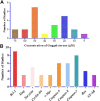Anti-cancer activity of guggulsterone by modulating apoptotic markers: a systematic review and meta-analysis
- PMID: 37201024
- PMCID: PMC10185795
- DOI: 10.3389/fphar.2023.1155163
Anti-cancer activity of guggulsterone by modulating apoptotic markers: a systematic review and meta-analysis
Abstract
Background: Guggulsterone (pregna-4,17-diene-3,16-dione; C21H28O2) is an effective phytosterol isolated from the gum resin of the tree Commiphora wightii (Family Burseraceae) and is responsible for many of the properties of guggul. This plant is widely used as traditional medicine in Ayurveda and Unani system of medicine. It exhibits several pharmacological activities, such as anti-inflammatory, analgesic, antibacterial, anti-septic and anticancer. In this article, the activities of Guggulsterone against cancerous cells were determined and summarized. Methods: Using 7 databases (PubMed, PMC, Google Scholar, Science Direct, Scopus, Cochrane and Ctri.gov), the literature search was conducted since conception until June 2021. Extensive literature search yielded 55,280 studies from all the databases. A total of 40 articles were included in the systematic review and of them, 23 articles were included in the meta-analysis.The cancerous cell lines used in the studies were for pancreatic cancer, hepatocellular carcinoma, head and neck squamous cell carcinoma, cholangiocarcinoma, oesophageal adenocarcinoma, prostrate cancer, colon cancer, breast cancer, gut derived adenocarcinoma, gastric cancer, colorectal cancer, bladder cancer, glioblastoma, histiocytic leukemia, acute myeloid leukemia and non-small cell lung cancer. The reliability of the selected studies was assessed using ToxRTool. Results: Based on this review, guggulsterone significantly affected pancreatic cancer (MiaPaCa-2, Panc-1, PC-Sw, CD18/HPAF, Capan1, PC-3), hepatocellular carcinoma (Hep3B, HepG2, PLC/PRF/5R), head and neck squamous cell carcinoma (SCC4, UM-22b, 1483), cholangiocarcinoma (HuCC-T1, RBE, Sk-ChA-1, Mz-ChA-1) and oesophageal adenocarcinoma (CP-18821, OE19), prostrate cancer (PC-3), colon cancer (HT-29), breast cancer (MCF7/DOX), gut derived adenocarcinoma (Bic-1), gastric cancer (SGC-7901), colorectal cancer (HCT116), bladder cancer (T24, TSGH8301), glioblastoma (A172, U87MG, T98G), histiocytic leukemia (U937), acute myeloid leukemia (HL60, U937) and non-small cell lung cancer (A549, H1975) by inducing apoptotic pathways, inhibiting cell proliferation, and regulating the expression of genes involved in apoptosis. Guggulsterone is known to have therapeutic and preventive effects on various categories of cancers. It can inhibit the progression of tumors and can even reduce their size by inducing apoptosis, exerting anti-angiogenic effects, and modulating various signaling cascades. In vitro studies reveal that Guggulsterone inhibits and suppresses the proliferation of an extensive range of cancer cells by decreasing intrinsic mitochondrial apoptosis, regulating NF-kB/STAT3/β-Catenin/PI3K/Akt/CHOP pathway, modulating the expression of associated genes/proteins, and inhibiting angiogenesis. Furthermore, Guggulsterone reduces the production of inflammatory markers, such as CDX2 and COX-2. The other mechanism of the Guggulsterone activity is the reversal of P-glycoprotein-mediated multidrug resistance. Twenty three studies were selected for meta-analysis following the PRISMA statements. Fixed effect model was used for reporting the odds ratio. The primary endpoint was percentage apoptosis. 11 of 23 studies reported the apoptotic effect at t = 24 h and pooled odds ratio was 3.984 (CI 3.263 to 4.865, p < 0.001). 12 studies used Guggulsterone for t > 24 h and the odds ratio was 11.171 (CI 9.148 to 13.643, 95% CI, p < 0.001). The sub-group analysis based on cancer type, Guggulsterone dose, and treatment effects. Significant alterations in the level of apoptotic markers were reported by Guggulsterone treatment. Conclusion: This study suggested that Guggulsterone has apoptotic effects against various cancer types. Further investigation of its pharmacological activity and mechanism of action should be conducted. In vivo experiments and clinical trials are required to confirm the anticancer activity.
Keywords: anti-cancer; apoptosis; guggulsterone; meta-analysis; systematic literature review.
Copyright © 2023 Gupta, Singh, Rastogi, Siddique, Al-Dayan, Ahmad, Sikander and Sarwat.
Conflict of interest statement
The authors declare that the research was conducted in the absence of any commercial or financial relationships that could be construed as a potential conflict of interest.
Figures







Similar articles
-
Guggulsterone from Commiphora mukul potentiates anti-glioblastoma efficacy of temozolomide in vitro and in vivo via down-regulating EGFR/PI3K/Akt signaling and NF-κB activation.J Ethnopharmacol. 2023 Jan 30;301:115855. doi: 10.1016/j.jep.2022.115855. Epub 2022 Oct 22. J Ethnopharmacol. 2023. PMID: 36280019
-
Guggulsterone sensitized drug-resistant human hepatocarcinoma cells to doxorubicin through a Cox-2/P-gp dependent pathway.Eur J Pharmacol. 2017 May 15;803:57-64. doi: 10.1016/j.ejphar.2017.03.045. Epub 2017 Mar 23. Eur J Pharmacol. 2017. PMID: 28342979
-
Guggulsterone inhibits human cholangiocarcinoma Sk-ChA-1 and Mz-ChA-1 cell growth by inducing caspase-dependent apoptosis and downregulation of survivin and Bcl-2 expression.Oncol Lett. 2015 Sep;10(3):1416-1422. doi: 10.3892/ol.2015.3391. Epub 2015 Jun 19. Oncol Lett. 2015. PMID: 26622683 Free PMC article.
-
Guggulsterone for Chemoprevention of Cancer.Curr Pharm Des. 2016;22(3):294-306. doi: 10.2174/1381612822666151112153117. Curr Pharm Des. 2016. PMID: 26561056 Review.
-
Anticancer Activities of Polygonum odoratum Lour.: A Systematic Review.Front Pharmacol. 2022 Apr 27;13:875016. doi: 10.3389/fphar.2022.875016. eCollection 2022. Front Pharmacol. 2022. PMID: 35571080 Free PMC article.
Cited by
-
The Importance of Genetic Screening on the Syndromes of Colorectal Cancer and Gastric Cancer: A 2024 Update.Biomedicines. 2024 Nov 21;12(12):2655. doi: 10.3390/biomedicines12122655. Biomedicines. 2024. PMID: 39767561 Free PMC article. Review.
-
Advances in the roles and molecular mechanisms of exosomal circular RNAs in regulating the pre-metastatic niche of tumors.Discov Oncol. 2025 Apr 19;16(1):568. doi: 10.1007/s12672-025-02374-w. Discov Oncol. 2025. PMID: 40252161 Free PMC article. Review.
References
Publication types
LinkOut - more resources
Full Text Sources
Research Materials
Miscellaneous

